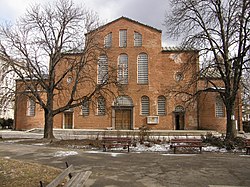Byzantine architecture

Byzantine architecture is the architectural style of the Byzantine Empire. This is a term used by modern historians to mean the Eastern Roman Empire based in Constantinople. The empire lasted for more than a millennium. It left a lasting influence on Medieval architecture in Europe and the Near East. It also influenced the later Renaissance architecture and Ottoman architecture.
As a distinctive style
Early Byzantine architecture evolved from Early Christian architecture.[1] The early Christian style typically was a basilica with three or five isles.[1] Usually they had wooden roofs. Vaults and domes were rarely used. Byzantine architecture rarely used three isle or five isle basilicas.[1] In this style domes were frequently used.[1] The Semi-dome was also used, especially over an apse.[2] It reached its highest form with the use of the pendentive. These are usually used to support a dome. The Byzantine pendentive is a geometric form using four triangular legs sitting on a square base.[3] It developed during the 6th century reign of the Byzantine Emperor Justinian I.[4] This is when Byzantine architecture became a distinctive style. Windowed domes were also a distinctive feature of this style.[5] The intent was to make the dome look like a crown with jewels of light.
Legacy
In the West, Byzantine architecture was replaced by Romanesque and Gothic architecture. In Asia it had an influence on early Islamic architecture. Later Ottoman architecture was also influenced by the Byzantine style.
Byzantine Architecture Media
Interior of the Basilica of San Vitale from Ravenna (Italy), decorated with elaborate and glamorous mosaics
Pammakaristos Church, also known as the Church of Theotokos Pammakaristos (Greek: Θεοτόκος ἡ Παμμακάριστος, "All-Blessed Mother of God"), is a Greek Orthodox Byzantine church in Istanbul
Church of Christ Pantocrator (13th-14th century), Nesebar, Bulgaria, late Byzantine cross-in-square style, UNESCO World Heritage Site
Hagia Irene is a former Greek Eastern Orthodox Church located in the outer courtyard of Topkapı Palace in Istanbul. It is the only Byzantine church in Istanbul that has not been converted into a mosque. The Hagia Irene today operates as a museum and concert hall.
The basilica of Sant'Apollinare Nuovo in Ravenna (6th century)
Saint Sofia Church, Bulgaria, 6th century AD
The 6th-century church of Hagia Irene in Istanbul was substantially rebuilt after an earthquake in the 8th century.
External view of the 11th-century monastery of Hosios Loukas in Greece. It is representative of the Byzantine art during the rule of the Macedonian dynasty (Macedonian art)
Rear courtyard of Church of St. Sophia, Ohrid, 9th century, First Bulgarian Empire, now North Macedonia
References
- ↑ 1.0 1.1 1.2 1.3 Alfred D. Hamlin, History of Architecture (Bremen: Salzwasser-Verl., 2010), p. 122
- ↑ The Grove Encyclopedia of Medieval Art and Architecture, Volume 2, ed. Colum Hourihane (New York: Oxford University Press, 2012). p. 303
- ↑ Russell Sturgis; Francis A. Davis, Sturgis Illustrated Dictionary of Architecture and Building, Vol. III O - Z (Mineola, NY: Dover, 1989), pp. 88–89
- ↑ Richard Krautheimer; Slobodan Curcic. Early Christian and Byzantine Architecture (New Haven, CT: Yale University Press, 1986), p. 238
- ↑ David Watkin, A History of Western Architecture (London: Laurence King, 2005), p. 103
Other websites
- Byzantine Architecture: History, Characteristics & Examples
- Byzantine / Byzantine Revival Architecture
| Wikimedia Commons has media related to Lua error in Module:Commons_link at line 62: attempt to index field 'wikibase' (a nil value).. |










